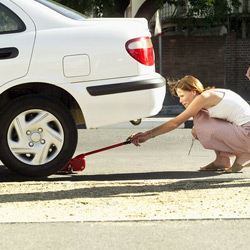Start the Countdown
Road trip: two words that promise summer adventure and fun. Car problems: two words that will kill that excitement in a heartbeat. A breakdown on the highway will turn your long-awaited vacation into the mechanic’s “pay-cation” and leave you with unpleasant memories.
While vehicles need maintenance year-round, driving long distances in high temperatures can be especially strenuous. Hot asphalt is tough on tires, and a faulty radiator won’t last long if tested under harsh conditions. So before you pack up the car and your friends and family and hit the road, take a short break, check a few vitals and make sure your ride is vacation-ready.
Check Your Tires

If you’re like most folks, you don’t notice your tires until one of them goes flat. But tires are one of the most essential features on a vehicle. First, make sure you don’t need new tires by checking for “wear bars” — darker strips of rubber that show when a tire is hopelessly worn. Even if you don’t see the bars, check the tread wear with the time-tested penny trick. Put a penny in the tread and roll it around. If the tread is so worn you can see Lincoln’s eyebrow, get a new tire.
Take a look at the spare, too, and know where your jack is while you’re at it. If your tires are in good shape, make sure they’re inflated to the correct levels — the right amount of pressure should be listed in your owner’s manual. Underinflated tires can explode, which is not the kind of road trip excitement you had in mind.
Check the Electrical System

Check the horn, windshield wipers, and all the interior and exterior lights in your vehicle before setting out on a road trip. Put a few extra fuses and bulbs in your toolbox in case something goes out on the road. You don’t want to waste valuable beach time looking for an auto parts store. Get someone to stand outside of the car while you try out the brake lights. A ticket is not a vacation souvenir you’ll cherish. Change the wiper blades, too — you know it’s been awhile. Make sure the air conditioner is working at peak performance, and take the vehicle to the shop if it seems to be a little sluggish. That road trip will seem much longer if you’re sweltering on the highway.
Look Under the Hood

Pop the hood and have a look underneath. Check every fluid — oil, power steering, brake, transmission and windshield washer fluid, too. You’ll want to wipe away each splattered bug your car encounters. While you’re under the hood, examine the hoses and belts for any cracks and splits. And don’t forget the battery — it’s marked with the month and year it was installed in the vehicle. If that date was more than three years ago, go ahead and spring for a new one: Its days are numbered. If you’re due for an oil change, have it done before you leave, and get a new air filter while you’re at it.
Test Your Car’s Safety Features

Before vacation starts, check some of your vehicle’s features that keep you and the family safe. Make sure the seat belts unreel and retract as they should after you buckle them. Debris can get caught in the seat belt retractor and keep the restraint from functioning properly. Check for excessive wear and fraying, too. A seat belt that snaps on impact won’t be any help.
Speaking of impact, test your brakes. This can be fun: In a low-traffic area, accelerate to about 50 mph, and then slam on the brakes. If it takes you more than 100 feet to stop, or if you notice strange noises or grinding sounds, get to a mechanic. You don’t want your vacation stopped short because of a car that won’t stop safely.
Being stuck by the side of the road is a helpless feeling. Before leaving home, put together an emergency kit with items that at the very least will get your vehicle patched up until you can get to the nearest mechanic. You can create the kit from scratch yourself, or you can buy one at an auto parts store and spruce it up with a few more necessities.
Here are some basics:
- Jumper cables
- Roadside flares
- 2 or 3 quarts of oil
- Gallon of anti-freeze
- Can of tire inflator
- Duct tape
- Flashlight
- Toolkit containing screwdriver, awl and wire cutters
Source: Howstuffworks.com

